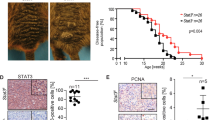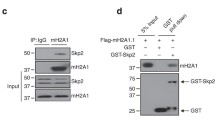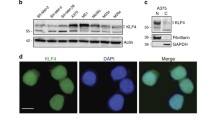Abstract
The proteins SKI and SnoN are implicated in processes as diverse as differentiation, transformation and tumor progression. Until recently, SKI was solely viewed as a nuclear protein with a principal function of inhibiting TGF-β signaling through its association with the Smad proteins. However, new studies suggest that SKI plays additional roles not only inside but also outside the nucleus. In normal melanocytes and primary non-invasive melanomas, SKI localizes predominantly in the nucleus, whereas in primary invasive melanomas SKI displays both nuclear and cytoplasmic localization. Intriguingly, metastatic melanoma tumors display nuclear and cytoplasmic or predominantly cytoplasmic SKI distribution. Cytoplasmic SKI is functional, as it associates with Smad3 and prevents its nuclear localization mediated by TGF-β. SKI can also function as a transcriptional activator, targeting the β -catenin pathway and activating MITF and NrCAM, two proteins involved in survival, migration and invasion. Intriguingly, SKI appears to live a dual life, one as a tumor suppressor and another as a transforming protein. Loss of one copy of mouse ski increases susceptibility to tumorigenesis in mice, whereas its overexpression is associated with cancer progression of human melanoma, esophageal, breast and colon. The molecular reasons for such dramatic change in SKI function appear to result from new acquired activities. In this review, we discuss the mechanisms by which SKI regulates crucial pathways involved in the progression of human malignant melanoma.
Similar content being viewed by others
References
Colmenares C, Stavnezer E: Structure and activities of the ski oncogene. Semin Cancer Biol 1: 383–387, 1990
Nicol R, Zheng G, Sutrave P, Foster DN, Stavnezer E: Association of specific DNA binding and transcriptional repression with the transforming and myogenic activities of c-Ski. Cell Growth Differ 10: 243–254, 1999
Medrano EE: Repression of TGF-beta signaling by the oncogenic protein SKI in human melanomas: Consequences for proliferation, survival, and metastasis. Oncogene 22: 3123–3129, 2003.
Harada J, Kokura K, Kanei-Ishii C, Nomura T, Khan MM, Kim Y, Ishii S: Requirement of the co-repressor homeodomain-interacting protein kinase 2 for ski-mediated inhibition of bone morphogenetic protein-induced transcriptional activation. J Biol Chem 278: 38998–39005, 2003.
Martin B, Schneider R, Janetzky S, Waibler Z, Pandur P, Kuhl M, Behrens J, Von Der MK, Starzinski-Powitz A, Wixler V: The LIM-only protein FHL2 interacts with {beta}-catenin promotes differentiation of mouse myoblasts. J Cell Biol 159: 113–122, 2002
Wei Y, Renard CA, Labalette C, Wu Y, Levy L, Neuveut C, Prieur X, Flajolet M, Prigent S, Buendia MA: Identification of the LIM protein FHL2 as a coactivator of beta-catenin. J Biol Chem 278: 5188–5194, 2003
Wilson JJ, Malakhova M, Zhang R, Joachimiak A, Hegde RS: Crystal structure of the dachshund homology domain of human SKI. Structure (Camb) 12: 785–792, 2004
Reed JA, Bales E, Xu W, Okan NA, Bandyopadhyay D, Medrano EE: Cytoplasmic localization of the oncogenic protein ski in human cutaneous melanomas in vivo: Functional implications for transforming growth factor Beta signaling. Cancer Res 61: 8074–8078, 2001
Fukuchi M, Nakajima M, Fukai Y, Miyazaki T, Masuda N, Sohda M, Manda R, Tsukada K, Kato H, Kuwano H: Increased expression of c-Ski as a co-repressor in transforming growth factor-beta signaling correlates with progression of esophageal squamous cell carcinoma. Int J Cancer 108: 818–824, 2004
Fujimoto T, Nishikawa A, Iwasaki M, Akutagawa N, Teramoto M, Kudo R: Gene expression profiling in two morphologically different uterine cervical carcinoma cell lines derived from a single donor using a human cancer cDNA array. Gynecol Oncol 93: 446–453, 2004
Buess M, Terracciano L, Reuter J, Ballabeni P, Boulay JL, Laffer U, Metzger U, Herrmann R, Rochlitz C: Amplification of SKI is a prognostic marker in early colorectal cancer. Neoplasia 6: 207–212, 2004
Zhang F, Lundin M, Ristimaki A, Heikkila P, Lundin J, Isola J, Joensuu H, Laiho M: Ski-related novel protein N (SnoN), a negative controller of transforming growth factor-beta signaling, is a prognostic marker in estrogen receptor-positive breast carcinomas. Cancer Res 63: 5005–5010, 2003
Nomura T, Tanikawa J, Akimaru H, Kanei-Ishii C, Ichikawa-Iwata E, Khan MM, Ito H, Ishii S: Oncogenic activation of c-Myb correlates with a loss of negative regulation by TIF1beta and Ski. J Biol Chem 279: 16715–16726, 2004
Jahagirdar BN, Miller JS, Shet A, Verfaillie CM: Novel therapies for chronic myelogenous leukemia. Exp Hematol 29: 543–556, 2001
Funato T, Satou J, Kozawa K, Fujimaki S, Miura T, Kaku M: Use of c-myb antisense oligonucleotides to increase the sensitivity of human colon cancer cells to cisplatin. Oncol Rep 8: 807–810, 2001
Fumagalli S, Doneda L, Nomura N, Larizza L: Expression of the c-ski proto-oncogene in human melanoma cell lines. Melanoma Res 3: 23–27, 1993
Kokura K, Kim H, Shinagawa T, Khan MM, Nomura T, Ishii S: The Ski-binding protein C184M negatively regulates tumor growth factor-beta signaling by sequestering the Smad proteins in the cytoplasm. J Biol Chem 278: 20133–20139, 2003
Wei Y, Renard CA, Labalette C, Wu Y, Levy L, Neuveut C, Prieur X, Flajolet M, Prigent S, Buendia, MA: Identification of the LIM protein FHL2 as a coactivator of beta-catenin. J Biol Chem 278: 5188–5194, 2003
Xu W, Angelis K, Danielpour D, Haddad MM, Bischof O, Campisi J, Stavnezer E, Medrano EE: Ski acts as a co-repressor with Smad2 and Smad3 to regulate the response to type beta transforming growth factor. Proc Natl Acad Sci USA 97: 5924–5929, 2000
Shi Y, Massague J: Mechanisms of TGF-beta signaling from cell membrane to the nucleus. Cell 113: 685–700, 2003
Massague J: How cells read TGF-beta signals. Nat Rev Mol Cell Biol 1: 169–178, 2000
Akiyoshi S, Inoue H, Hanai J, Kusanagi K, Nemoto N, Miyazono K, Kawabata M: c-Ski acts as a transcriptional co-repressor in transforming growth factor-beta signaling through interaction with smads. J Biol Chem 274: 35269–35277, 1999
Prunier C, Pessah M, Ferrand N, Seo SR, Howe P, Atfi A: The oncoprotein Ski acts as an antagonist of transforming growth factor-beta signaling by suppressing Smad2 phosphorylation. J Biol Chem 278: 26249–26257, 2003
Suzuki H, Yagi K, Kondo M, Kato M, Miyazono K, Miyazawa K: c-Ski inhibits the TGF-beta signaling pathway through stabilization of inactive Smad complexes on Smad-binding elements. Oncogene 2004
Wellbrock C, Ogilvie L, Hedley D, Karasarides M, Martin J, Niculescu-Duvaz D, Springer CJ, Marais R: V599EB-RAF is an oncogene in melanocytes. Cancer Res 64: 2338–2342, 2004
Tokitou F, Nomura T, Khan MM, Kaul SC, Wadhwa R, Yasukawa T, Kohno I, Ishii S: Viral ski inhibits retinoblastoma protein (Rb)-mediated transcriptional repression in a dominant negative fashion. J Biol Chem 274: 4485–4488, 1999
Prathapam T, Kuhne C, Banks L: Skip interacts with the retinoblastoma tumor suppressor and inhibits its transcriptional repression activity. Nucleic Acids Res 30: 5261–5268, 2002
Khan MM, Nomura T, Kim H, Kaul SC, Wadhwa R, Shinagawa T, Ichikawa-Iwata E, Zhong S, Pandolfi PP, Ishii S: Role of PML and PML-RARalpha in Mad-mediated transcriptional repression. Mol Cell 7: 1233–1243, 2001
Yang FC, Merlino G, Chin L: Genetic dissection of melanoma pathways in the mouse. Semin Cancer Biol 11: 261–268, 2001
Bardeesy N, Bastian BC, Hezel A, Pinkel D, DePinho RA, Chin L: Dual inactivation of RB and p53 pathways in RAS-induced melanomas. Mol Cell Biol 21: 2144–2153, 2001
Tietze MK, Chin L: Murine models of malignant melanoma. Mol Med Today 6: 408–410, 2000
Chen D, Xu W, Bales E, Colmenares C, Conacci-Sorrell M, Ishii S, Stavnezer E, Campisi J, Fisher DE, Ben Ze’ev A, Medrano EE: SKI activates Wnt/beta-catenin signaling in human melanoma. Cancer Res 63: 6626–6634, 2003
El Mourabit H, Muller S, Tunggal L, Paulsson M, Aumailley M: Analysis of the adaptor function of the LIM domain-containing protein FHL2 using an affinity chromatography approach. J Cell Biochem 92: 612–625, 2004
Schmeichel KL, Beckerle MC: Molecular dissection of a LIM domain. Mol Biol Cell 8: 219–230, 1997
Dawid IB, Breen JJ, Toyama R: LIM domains: multiple roles as adapters and functional modifiers in protein interactions. Trends Genet 14: 156–162, 1998
Muller JM, Isele U, Metzger E, Rempel A, Moser M, Pscherer A, Breyer T, Holubarsch C, Buettner R, Schule R: FHL2, a novel tissue-specific coactivator of the androgen receptor. EMBO J 19: 359–369, 2000
Chan KK, Tsui SK, Ngai SM, Lee SM, Kotaka M, Waye MM, Lee CY, Fung KP: Protein-protein interaction of FHL2, a LIM domain protein preferentially expressed in human heart, with hCDC47. J Cell Biochem 76: 499–508, 2000
Tanahashi H, Tabira T: Alzheimer’s disease-associated presenilin 2 interacts with DRAL, an LIM- domain protein. Hum Mol Genet 9: 2281–2289, 2000
Dye BT, Patton JG: An RNA recognition motif (RRM) is required for the localization of PTB-associated splicing factor (PSF) to subnuclear speckles. Exp Cell Res 263: 131–144, 2001
Ng EK, Chan KK, Wong CH, Tsui SK, Ngai SM, Lee SM, Kotaka M, Lee CY, Waye MM, Fung KP: Interaction of the heart-specific LIM domain protein, FHL2, with DNA-binding nuclear protein, hNP220. J Cell Biochem 84: 556–566, 2002
Stilo R, Leonardi A, Formisano L, Di Jeso B, Vito P, Liguoro D: TUCAN/CARDINAL and DRAL participate in a common pathway for modulation of NF-kappaB activation. FEBS Lett 521: 165–169, 2002
McLoughlin P, Ehler E, Carlile G, Licht JD, Schafer BW: The LIM-only protein DRAL/FHL2 interacts with and is a corepressor for the promyelocytic leukemia zinc finger protein. J Biol Chem 277: 37045–37053, 2002
Lange S, Auerbach D, McLoughlin P, Perriard E, Schafer BW, Perriard JC, Ehler E: Subcellular targeting of metabolic enzymes to titin in heart muscle may be mediated by DRAL/FHL-2. J Cell Sci 115: 4925–4936, 2002
Yan J, Zhu J, Zhong H, Lu Q, Huang C, Ye Q: BRCA1 interacts with FHL2 and enhances FHL2 transactivation function. FEBS Lett 553: 183–189, 2003
Scholl FA, McLoughlin P, Ehler E, de Giovanni C, Schafer BW: DRAL is a p53-responsive gene whose four and a half LIM domain protein product induces apoptosis. J Cell Biol 151: 495–506, 2000
Widlund HR, Fisher DE: Microphthalamia-associated transcription factor: A critical regulator of pigment cell development and survival. Oncogene 22: 3035–3041, 2003
Goding CR: Mitf from neural crest to melanoma: signal transduction and transcription in the melanocyte lineage. Genes Dev 14: 1712–1728, 2000
Yasumoto K, Takeda K, Saito H, Watanabe K, Takahashi K, Shibahara S: Microphthalmia-associated transcription factor interacts with LEF-1, a mediator of Wnt signaling. EMBO J 21: 2703–2714, 2002
Chu W, Pak BJ, Bani MR, Kapoor M, Lu SJ, Tamir A, Kerbel RS, Ben David Y: Tyrosinase-related protein 2 as a mediator of melanoma specific resistance to cis-diamminedichloroplatinum(II): therapeutic implications. Oncogene 19: 395–402, 2000
Conacci-Sorrell ME, Ben Yedidia T, Shtutman M, Feinstein E, Einat P, Ben Ze’ev A: Nr-CAM is a target gene of the beta-catenin/LEF-1 pathway in melanoma and colon cancer and its expression enhances motility and confers tumorigenesis. Genes Dev 16: 2058–2072, 2002
Siegel PM, Massague J: Cytostatic and apoptotic actions of TGF-beta in homeostasis and cancer. Nat Rev Cancer 3: 807–821, 2003
Rodeck U, Nishiyama T, Mauviel A: Independent regulation of growth and SMAD-mediated transcription by transforming growth factor beta in human melanoma cells. Cancer Res 59: 547–550, 1999
Berking C, Takemoto R, Schaider H, Showe L, Satyamoorthy K, Robbins P, Herlyn M: Transforming Growth Factor-beta1 Increases Survival of Human Melanoma through Stroma Remodeling. Cancer Res 61: 8306–8316, 2001
De Wever O, Mareel M: Role of tissue stroma in cancer cell invasion. J Pathol 200: 429–447, 2003
Ayala G, Tuxhorn JA, Wheeler TM, Frolov A, Scardino PT, Ohori M, Wheeler M, Spitler J, Rowley DR: Reactive stroma as a predictor of biochemical-free recurrence in prostate cancer. Clin Cancer Res 9: 4792–4801, 2003
van Es JH, Barker N, Clevers H: You Wnt some, you lose some: Oncogenes in the Wnt signaling pathway. Curr Opin Genet Dev 13: 28–33, 2003
Smalley MJ, Dale TC: Wnt signalling in mammalian development and cancer. Cancer Metastasis Rev 18: 215–230, 1999
Derynck R, Zhang YE: Smad-dependent and Smad-independent pathways in TGF-beta family signalling. Nature 425: 577–584, 2003




